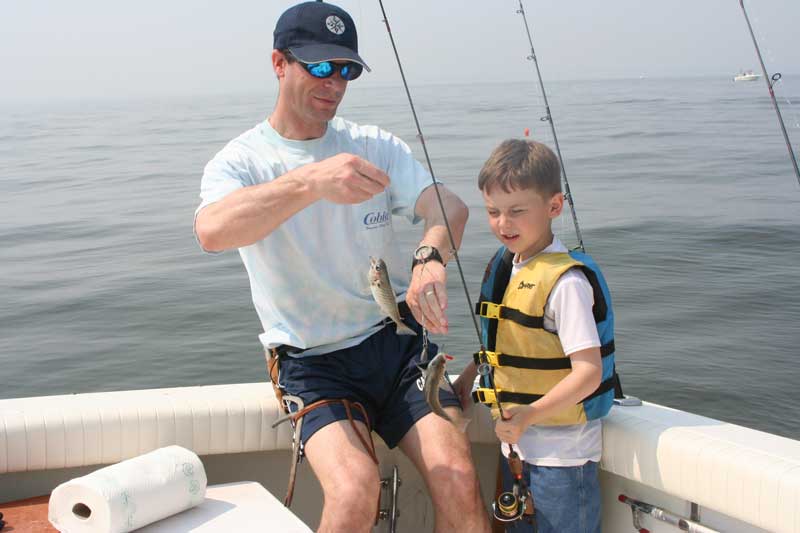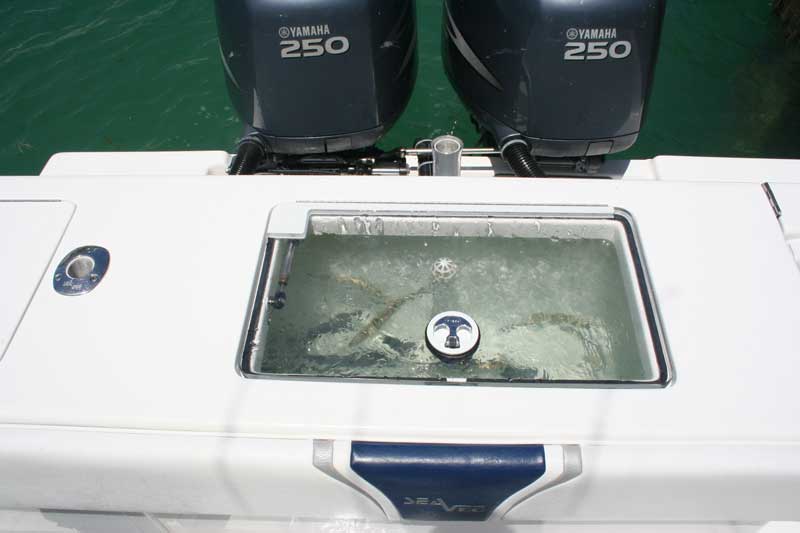Let’s face it, making bait is part of fishing – anyone who has ever spent much time on Chesapeake Bay fishing for any species knows it. Unless you don’t mind spending the dough and you have a reliable source for purchasing the live bait you need, you will spend time catching your own. I must admit it, I have spent a lot of time catching spot and croakers to feed to larger fish, not to mention mornings spent hunting for crabs, setting a minnow trap, or cast-netting mullet. But stop thinking of bait fishing as a necessary pre-game chore and begin viewing it as part of the game – fishing is fishing. Plus, you get to save a buck.

Years ago I worked on my days off as a mate on a charter boat that spent a lot of time hunting for amberjack. Our primary fishing location was the Chesapeake Light Tower (off the coast of Virginia Beach), and our primary bait was spot and croakers caught first thing in the morning on the way out. It always seemed to me that the easier it was to make bait, the harder the fishing was that day. The amberjack fishing always seemed better when we struggled to find the bait.
Maybe I should stop here and state that when I was a kid, those spot and croakers we caught on the way out would have been the catch of the day. My dad used to say that when he was young, living in the Ocean View section of Norfolk, they would have starved to death if it weren’t for croakers. I’ll add that if you have never had a mess of fried spot, you’re missing one of the best-tasting fish to come out of the Chesapeake Bay. Whether you catch a bunch to eat or to use as bait, of course, first you have to get them biting.
How to Catch Small Baitfish
Every region has its own variety of small fish that big fish like to eat. I’ve already mentioned spot and croakers in our area. Bait-sized specimens are typically smaller than eating-sized. Of course, that is partly dictated by the size of the fish you’re targeting with the live bait. These baitfish start showing up in our area in spring and stay until the fall. We typically get a run of eating-size spot (over a half a pound) around September. That’s usually the last of the spot each year. Croakers will stick around a bit longer.
If you use a cast net, you will encounter menhaden and mullet as well. Finger mullet are very popular with flounder anglers. Menhaden (bunker) are difficult to keep alive in large numbers, but make a good live bait for a variety of species.
For those bait fish caught on hook and line, I always use one of two rigs. The rig I use the most is the standard “over and under” type that may be found anywhere saltwater tackle is sold in our region. This rig is designed to use two hooks snelled to short leaders, and a small sinker. I use number-four or number-six hooks sold by companies like Eagle Claw and Bear Paw. The hooks are sold in six packs, and often come adorned with small spinner blades and beads. I rarely need more than a two-ounce sinker since I usually fish for bait in shallow, protected water.
The other rig is even simpler. I attach number-four or number-six hooks to short dropper loops about a foot apart, formed out of fluorocarbon leader material. Then I’ll tie a loop in the end of the leader to add a sinker. This rig sometimes works better around the pilings of a fishing pier.

My go-to bait to use for catching bait fish is one-inch pieces of Fishbites bloodworm Bag O’Worms. The bait comes in long strips that may be cut with a knife or scissors. The nice thing about these is that you can keep the packs of bait in your tackle bag without worrying about them spoiling. Hook the strip near one end so that it flutters naturally, and just about every small fish in the bay will bite these baits.
Bait fish are often structure oriented. I like to find water moving around a bridge, pier, dock, jetty or breakwater. Sometimes the bait will be close to the structure, other times they will not. Big schools of bait will show up on sonar. When fishing a hole that usually produces, I typically work the whole area thoroughly before moving on. Spot and croakers will sometimes be found in open water not far from the structure; drift these areas, in search of the school.
Once caught, baitfish should be kept in a livewell. You could keep a few alive in a bucket for a while by changing out the water regularly, but you’ll eventually lose them. It is also important that you don’t over-fill the live well – too many fish fighting for oxygen spells trouble.
What Fish Eat Fish?
Just about all fish like to eat fish. Here are a few species in our inshore waters that just love their lunch to be alive:
- Flounder – Large flounder will eat a four- to eight-inch live bait. Try dropping down a live bait on a single-hook flounder rig around the pilings of the Chesapeake Bay Bridge Tunnel – I’d tell you exactly where, but that’s for another article.
- Red Drum – Big reds will gulp down a six- to eight-inch livie in a heartbeat. If the school is on the surface lob the bait to the edge of the school, on an 8/0 circle hook tied to a stout leader. If the school is on the bottom, add an appropriate sinker to the running line using a fish-finder-style rig.
- Stripers – Stripers will eat just about anything when they’re actively feeding, but spot in the four- to six-inch range deserve the moniker “rockfish candy.” Use the same techniques and rigging as for the red drum. Of course, they also love live eels. (See How to Liveline with Spot Part I and Part II, for more details on catching stripers with live spot).
- Cobia – Cobia are known to love eels, too, but I’ve caught plenty of them on spot and croakers. When chumming, add a live fish to the mix either on the bottom near the chum bag, or in BFE (way behind the boat) on the surface. A free-swimming cobia will also eat a spot or croaker cast in front of him.
- Gray Trout - I know we haven’t seen big grays in the bay for several years, but when they do come back, they also eat live bait with abandon.
- Bluefish – We also haven’t seen big blues in quite some time either, but when they return to Chesapeake waters you can bet they’ll eat livies (as well as anything else) with abandon, too.

How to Put Baitfish on a Hook
Most of the time, I hook live baitfish up through the bottom jaw and out through the top jaw. You can hook them through the eye sockets as well. When anchored in slow moving water, you may try hooking a livey through the “shoulders” or in front of the tail, and send him down with no additional weight. They will typically swim to the bottom when hooked near the tail and this may work when nothing else is working. No matter how you hook the bait, make sure it doesn’t spin when in the water – fish prefer their lunch to look natural.
-By Chuck Harrison